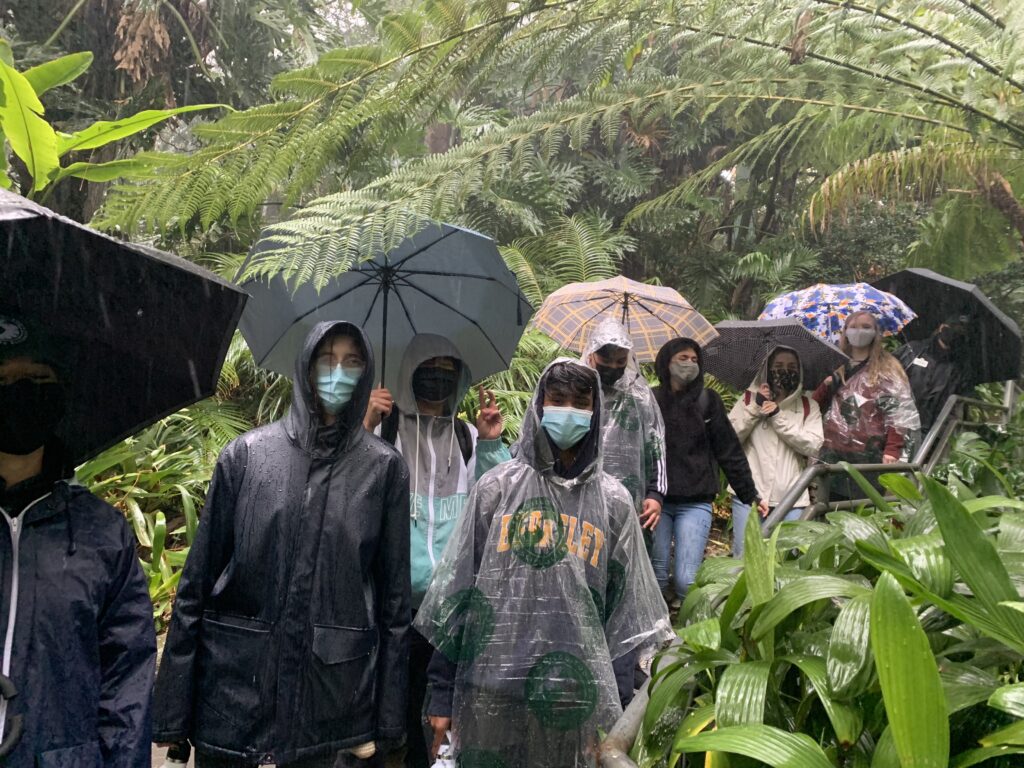Zoo InternQuest is a seven-week career exploration program for San Diego County high school juniors and seniors. Students have the unique opportunity to meet professionals working for the San Diego Zoo Wildlife Alliance, to learn about their jobs, and then blog about their experience online. Follow their adventures here on the Zoo’s website!
It was a scenic afternoon, grey and very, very wet. The concrete was drenched unevenly with puddles, some shallow, others a couple inches deep, scattering as the occasional footstep splashed through. Eleven people, eight interns and three Educator Guides, were to embark on their first presentation: a trip through the San Diego Zoo accompanied by some special guests.

The San Diego Zoo is not only known for their animals, but also for their fantastic educational programs. The Zoo’s achievement in this field would not be possible without the efforts of Educator Guides like Ms. Adriana Blair, Ms. Gabrielle Bartolon, and Ms. Maya O’Connor. Their responsibilities include VIP tours, educational programs with local school children, many different outreach projects, and wildlife ambassador presentations. Some of their other duties include scheduling meetings and programs, working with kids and Zoo visitors, and developing curriculum. They even help other staff around the Zoo with wildlife care or maintenance. They are a part of a huge team of employees who collaborate with each other to keep things running smoothly. Ms. Blair, Ms. Bartolon, Ms. O’Connor and their coworkers also work with a special group of animals called wildlife ambassadors which they help train to participate in the many outreach programs. These animals act as representatives of their species and habitats, inspiring people to care about the environment. Educator Guides also use a variety of other resources like animated digital zebra puppets and guest speakers to teach their audiences about the residents of the Zoo and the importance of conservation. Through these initiatives, they are able to inspire future generations of scientists and ecologically minded individuals, helping save wildlife one lesson at a time.

The Educator Guides have all had unique and interesting experiences that have helped them land their current job. All three have college degrees–Ms. Blair and Ms. O’Connor both graduated from University of California, Davis and Ms. Bartolon graduated from California Polytechnic University, Pomona. Ms. Blair interned at the Living Coast Discovery Center for almost a year in their raptor department, building animal handling skills. She also spent a summer working with kids as a camp counselor in Japan during college! Ms. O’Connor took internships pertaining more to domestic animals, such as working at goat dairy or at a veterinary clinic. Ms. Bartolon interned at a wildlife rehabilitation center and was a reptile keeper. All of their experiences gave them opportunities to work closely with different animal species, a key component of their current position working with wildlife ambassadors.

Have you ever heard of a tamandua? You might recognize its other name: lesser anteater. The lesser anteater is found in forests of South America and lives mainly in the trees. They are great climbers, especially with the help of their semi-prehensile tail. In the wild, tamanduas eat ants and termites. At the Zoo, Otis the tamandua ambassador likes to eat wax worms, avocado, and mealworms. To find their food, they have developed an impressive sense of smell. They can smell the difference between ants that can sting and ones that cannot; this helps them avoid getting stung. They have sharp claws that help them dig into termite mounds and anthills and an extremely long tongue that they use to catch the bugs. Their tongues can grow up to 16 inches long! The interns got to see Otis’s long tongue in action when he licked up all the wax worms he was given. His sticky saliva made the insects stick to the side of the tube he was given so he could get them more easily. Along with their sense of smell, tamanduas also exude a very stinky smell themselves. They are known as the “stinkers of the forest.” This smell helps deter any predators that might come their way, making them a cute but smelly species. Tamanduas are not endangered, but it is up to us to keep it that way!


Our Educator Guides, Ms. Blair, Ms. Bartolon, and Ms. O’Connor, are dedicated to projects that focus on teaching conservation. In addition to meeting Otis, the interns got the opportunity to meet a porcupine named Icana. As was presented, there are many everyday changes the general public can make to help conserve wildlife living in forests like Icana. Purchasing wooden products that are Forest Stewardship Council (FSC) certified and by cutting down on palm oil products are ways to help support sustainable forestry. Palm oil is cultivated by cutting down habitats and replacing them with plantations. A more conservation-friendly way of consuming the oil is by substituting it with sustainable palm oil certified by the Roundtable on Sustainable Palm Oil (RSPO). Experiences as eye opening as meeting a wildlife ambassador create a face to face impact on the public’s understanding and interest of conservation; they state it’s one of their favorite things about being educators. In their career they link people to wildlife, educate and engage them with the wildlife ambassadors, and gradually, these all lead to inspiration. Ultimately, people tend to seek out these enlightening experiences over and over again, giving them the inspiration to support conservation and share this passion with others.


With all of the fantastic aspects of their jobs, our presenters were bound to have some favorites. Some of the favorite wildlife ambassadors they work with included animals like pangolins (the most trafficked animal in the world), a sloth named Xena (who is very engaging), and a porcupine named Maizey (who apparently has a BIG personality). When asked for their favorite parts of their job the answers varied, but it was clear they have a passion for what they do. Ms. Bartolon’s favorite part is when she is able to see the moment she makes a difference in a person’s life by igniting their passion for wildlife. For Ms. O’Connor, her favorite part of the job is the impact it has on kids who choose the Zoo as part of their wish for the Make-A-Wish program. “We get letters from families telling us about how special it was to [the kids], and I feel grateful to have been part of something that made them really happy,” she said. Ms. Blair, when asked, said that her favorite part is when it is evident that someone is having a good time. “When I can see on people’s faces that they’re having a great day and they’re being blown away by all of the stuff they’re seeing, that’s what makes our job special for me.” Despite their different answers, it’s clear they have a very similar passion for their work and impact on the people they engage with, and look forward to getting up and going to work every day.
It is not often that you hear people talk about their job so enthusiastically and with so few complaints. With a workday that is never the same, Ms. O’Connor, Ms. Blair, and Ms. Bartolon all love their jobs as Educator Guides. Each new day comes with exciting new responsibilities: focusing on education outreach, working with wildlife ambassadors, and giving tours to guests at the Zoo. Reflecting on their unique journeys, the Educators all agreed that having an open mind and trying new things, both in and out of school, were crucial to finding their passion for education. From working at vet clinics, farms, and wildlife rehabilitation centers, to studying mushroom cultivation and tractor driving in school, it was the opportunities Ms. O’Connor, Ms. Blair, and Ms. Bartolon least expected that had the most significant impact on getting to where they are today. As Ms. O’Connor said, “You spend most of your life working, might as well do something that you love.”

In this experience, the interns learned quite a bit about what to expect in the coming weeks, and met some furry (and spiky) friends along the way. With the assistance of Educators Ms. Blair, Ms. Bartolon, and Ms. O’Connor, the wildlife ambassadors strutted their stuff for all to see. The interns also learned about a career associated with exotic animal care and their prerequisites. It was clear as day that this experience was a fun and memorable one, even if that day wasn’t exactly sunny.
Week One, Spring Session 2021


